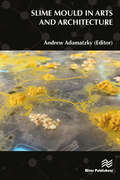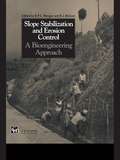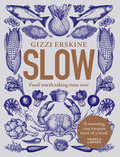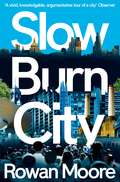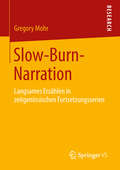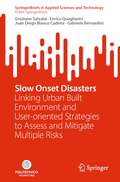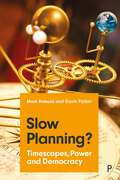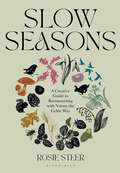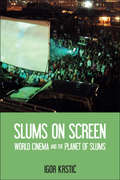- Table View
- List View
Slime Mould in Arts and Architecture
by Andrew AdamatzkyThe slime mould Physarum polycephalum was a source of explosive growth of bioengineered hybrid sensing and computing devices in the past decade. Being in its vegetative state, the plasmodium, the slime mould configures its protoplasmic network to optimize its geometry with relation to patterns of attractants and repellents.The slime mould’s adaptability, polymorphism and aestheticism inspired artists and architects. The slime mould has been seen as a self-conscious liquid form continuously changing its shape in response to external stimulation and due to interactions of thousands of micro-oscillators in its body. Elusiveness is a magic feature of the slime mould. One moment the slime mould gives you a solution to a mathematical problem by a shape of its body, next moment it changes its shape and the solution ,disappears.Slime Mould in Arts and Architecture presents a set of unique chapters written by leading artists, architects and scientists, which resulted from creative translations of the slime mould behaviour into forms and sounds, unconventional investigations and sensorial experiences and the slime mould ability to remove boundaries between living and artificial, solid and fluid, science and arts. The book gives readers unique tools for designing architectural forms and creative works using the slime mould, understanding how pro-cognitive living substrates can be used in everyday life, it sparks new ideas and initiates further progress in many fields or arts, architecture, science and engineering.
Slime Mould in Arts and Architecture
The slime mould Physarum polycephalum was a source of explosive growth of bioengineered hybrid sensing and computing devices in the past decade. Being in its vegetative state, the plasmodium, the slime mould configures its protoplasmic network to optimize its geometry with relation to patterns of attractants and repellents.The slime mould’s adaptability, polymorphism and aestheticism inspired artists and architects. The slime mould has been seen as a self-conscious liquid form continuously changing its shape in response to external stimulation and due to interactions of thousands of micro-oscillators in its body. Elusiveness is a magic feature of the slime mould. One moment the slime mould gives you a solution to a mathematical problem by a shape of its body, next moment it changes its shape and the solution ,disappears.Slime Mould in Arts and Architecture presents a set of unique chapters written by leading artists, architects and scientists, which resulted from creative translations of the slime mould behaviour into forms and sounds, unconventional investigations and sensorial experiences and the slime mould ability to remove boundaries between living and artificial, solid and fluid, science and arts. The book gives readers unique tools for designing architectural forms and creative works using the slime mould, understanding how pro-cognitive living substrates can be used in everyday life, it sparks new ideas and initiates further progress in many fields or arts, architecture, science and engineering.
Slope Stabilization and Erosion Control: A Bioengineering Approach
by Roy P.C. Morgan R.J. RicksonThis book is an up-to-date review of research and practice on the use of vegetation for slope stabilization and control of surface erosion caused by water and wind. From a basic understanding of the principles and practices of vegetation growth and establishment, it describes how vegetation can be treated as an engineering material and used to solve erosion and slope stability problems.
Slope Stabilization and Erosion Control: A Bioengineering Approach
by Roy P.C. Morgan R.J. RicksonThis book is an up-to-date review of research and practice on the use of vegetation for slope stabilization and control of surface erosion caused by water and wind. From a basic understanding of the principles and practices of vegetation growth and establishment, it describes how vegetation can be treated as an engineering material and used to solve erosion and slope stability problems.
Sloppy Craft: Postdisciplinarity and the Crafts
by Elaine Cheasley Paterson Susan SuretteSloppy Craft: Postdisciplinarity and the Crafts brings together leading international artists and critics to explore the possibilities and limitations of the idea of 'sloppy craft' – craft that is messy or unfinished looking in its execution or appearance, or both. The contributors address 'sloppiness' in contemporary art and craft practices including painting, weaving, sewing and ceramics, consider the importance of traditional concepts of skill, and the implications of sloppiness for a new 21st century emphasis on inter- and postdisciplinarity, as well as for activist, performance, queer and Aboriginal practices.In addition to critical essays, the book includes a 'conversation' section in which contemporary artists and practitioners discuss challenges and opportunities of 'sloppy craft' in their practice and teaching, and an afterword by Glenn Adamson.
Sloppy Craft: Postdisciplinarity and the Crafts
by Elaine Cheasley Paterson Susan SuretteSloppy Craft: Postdisciplinarity and the Crafts brings together leading international artists and critics to explore the possibilities and limitations of the idea of 'sloppy craft' – craft that is messy or unfinished looking in its execution or appearance, or both. The contributors address 'sloppiness' in contemporary art and craft practices including painting, weaving, sewing and ceramics, consider the importance of traditional concepts of skill, and the implications of sloppiness for a new 21st century emphasis on inter- and postdisciplinarity, as well as for activist, performance, queer and Aboriginal practices.In addition to critical essays, the book includes a 'conversation' section in which contemporary artists and practitioners discuss challenges and opportunities of 'sloppy craft' in their practice and teaching, and an afterword by Glenn Adamson.
Slow: Food Worth Taking Time Over
by Gizzi Erskine‘A warming cosy treasure trove of a book’ Nigella Lawson ‘A sumptuous volume of recipes that urges you to linger in the kitchen.’ The Telegraph Food worth taking time over
A Slow Air
by David HarrowerMorna works as a cleaner in Edinburgh. She spends her time drinking, attempting affairs and trying to work out the mind of the twenty-year-old son with whom she shares her flat. Her elder brother, Athol, lives near Glasgow airport with his wife. The owner of a floor-tiling company, with two grown-up children, he's proud of his hard-won achievements since moving west.Between them, they have differing memories of their upbringing and their parents and definite opinions about each other. But these are left unsaid because Morna and Athol haven't spoken a word to each other in fourteen years . . . When Morna's son Joshua travels to see his uncle, he sets off a remarkable and life-changing series of events.A Slow Air by David Harrower premiered at the Tron Theatre, Glasgow, in April 2011, and transferred to the Traverse Theatre as part of the Edinburgh Fringe Festival.
Slow Burn City: London in the Twenty-First Century
by Rowan MooreWith a new introduction for the paperback.London is a supreme achievement of civilization. It offers fulfilments of body and soul, encourages discovery and invention. It is a place of freedom, multiplicity and co-existence. It is a Liberal city, which means it stands for values now in peril. London has also become its own worst enemy, testing to destruction the idea that the free market alone can build a city, a fantastical wealth machine that denies too many of its citizens a decent home or living. In this thought-provoking, fearless, funny and subversive book, Rowan Moore shows how London’s strength depends on the creative and mutual interplay of three forces: people, business and state. To find responses to the challenges of the twenty-first century, London must rediscover its genius for popular action and bold public intervention. The global city above all others, London is the best place to understand the way the world’s cities are changing. It could also be, in the shape of a living, churning city of more than eight million people, the most powerful counter-argument to the extremist politics of the present.
Slow-Burn-Narration: Langsames Erzählen in zeitgenössischen Fortsetzungsserien
by Gregory MohrGregory Mohr untersucht am Beispiel der Serie Better Call Saul und anderer zeitgenössischer Serien die Erzählarchitektur aktueller Fortsetzungsstaffeln und stellt dabei die Verfahren der Langsamkeit und den daraus resultierenden erzählerischen Gewinn ins Zentrum der Analyse. Damit liefert er in diesem bisher unterrepräsentierten Forschungsbereich einen Beitrag zur Diskussion um die qualitative Aufwertung und Komplexitätszunahme in TV-Serien, die sich in sozialen Netzwerken, Feuilletons und wissenschaftlichen Diskursen einen festen Platz gesichert haben. Mit dem langsamen Erzählen tritt ein noch junges Phänomen hinzu, das gleichzeitig als Schlaglicht vieler zeitgenössischer Serien zu bemerken ist.
Slow Cinema (Traditions in World Cinema)
by Tiago De Luca Nuno Barradas JorgeIn the context of a frantic world that celebrates instantaneity and speed, a number of cinemas steeped in contemplation, silence and duration have garnered significant critical attention in recent years, thus resonating with a larger sociocultural movement whose aim is to rescue extended temporal structures from the accelerated tempo of late-capitalism. Although not part of a structured film movement, directors such as Carlos Reygadas, Tsai Ming-liang, Béla Tarr, Pedro Costa and Kelly Reichardt have been largely subsumed under the term ‘slow cinema’. But what exactly is slow cinema? Is it a strictly recent phenomenon or an overarching cinematic tradition? And how exactly do slow cinemas interrelate on an aesthetic, technical and political level? Deploying the concept of slowness as an umbrella category under which filmmakers and traditions from different historical and geographical backgrounds can fruitfully converge, this innovative collection of essays interrogates and expands the frameworks that have generally informed slow cinema debates. Repositioning the term in a broader theoretical space, the book combines an array of fine-grained studies that will provide valuable insight into the notion of slowness in the cinema, while mapping out past and contemporary slow films across the globe.
Slow Cinema (Traditions in World Cinema)
by Tiago De Luca Nuno Barradas JorgeIn the context of a frantic world that celebrates instantaneity and speed, a number of cinemas steeped in contemplation, silence and duration have garnered significant critical attention in recent years, thus resonating with a larger sociocultural movement whose aim is to rescue extended temporal structures from the accelerated tempo of late-capitalism. Although not part of a structured film movement, directors such as Carlos Reygadas, Tsai Ming-liang, Béla Tarr, Pedro Costa and Kelly Reichardt have been largely subsumed under the term ‘slow cinema’. But what exactly is slow cinema? Is it a strictly recent phenomenon or an overarching cinematic tradition? And how exactly do slow cinemas interrelate on an aesthetic, technical and political level? Deploying the concept of slowness as an umbrella category under which filmmakers and traditions from different historical and geographical backgrounds can fruitfully converge, this innovative collection of essays interrogates and expands the frameworks that have generally informed slow cinema debates. Repositioning the term in a broader theoretical space, the book combines an array of fine-grained studies that will provide valuable insight into the notion of slowness in the cinema, while mapping out past and contemporary slow films across the globe.
Slow Fade to Black
by Thomas CrippsSet against the backdrop of the black struggle in society, Slow Fade to Black is the definitive history of African-American accomplishment in film--both before and behind the camera--from the earliest movies through World War II. As he records the changing attitudes toward African-Americans both in Hollywood and the nation at large, Cripps explores the growth of discrimination as filmmakers became more and more intrigued with myths of the Old South: the "lost cause" aspect of the Civil War, the stately mansions and gracious ladies of the antebellum South, the "happy" slaves singing in the fields. Cripps shows how these characterizations culminated in the blatantly racist attitudes of Griffith's The Birth of a Nation, and how this film inspired the N.A.A.C.P. to campaign vigorously--and successfully--for change. While the period of the 1920s to 1940s was one replete with Hollywood stereotypes (blacks most often appeared as domestics or "natives," or were portrayed in shiftless, cowardly "Stepin Fetchit" roles), there was also an attempt at independent black production--on the whole unsuccessful. But with the coming of World War II, increasing pressures for a wider use of blacks in films, and calls for more equitable treatment, African-Americans did begin to receive more sympathetic roles, such as that of Sam, the piano player in the 1942 classic Casablanca. A lively, thorough history of African-Americans in the movies, Slow Fade to Black is also a perceptive social commentary on evolving racial attitudes in this country during the first four decades of the twentieth century.
Slow Fade to Black
by Thomas CrippsSet against the backdrop of the black struggle in society, Slow Fade to Black is the definitive history of African-American accomplishment in film--both before and behind the camera--from the earliest movies through World War II. As he records the changing attitudes toward African-Americans both in Hollywood and the nation at large, Cripps explores the growth of discrimination as filmmakers became more and more intrigued with myths of the Old South: the "lost cause" aspect of the Civil War, the stately mansions and gracious ladies of the antebellum South, the "happy" slaves singing in the fields. Cripps shows how these characterizations culminated in the blatantly racist attitudes of Griffith's The Birth of a Nation, and how this film inspired the N.A.A.C.P. to campaign vigorously--and successfully--for change. While the period of the 1920s to 1940s was one replete with Hollywood stereotypes (blacks most often appeared as domestics or "natives," or were portrayed in shiftless, cowardly "Stepin Fetchit" roles), there was also an attempt at independent black production--on the whole unsuccessful. But with the coming of World War II, increasing pressures for a wider use of blacks in films, and calls for more equitable treatment, African-Americans did begin to receive more sympathetic roles, such as that of Sam, the piano player in the 1942 classic Casablanca. A lively, thorough history of African-Americans in the movies, Slow Fade to Black is also a perceptive social commentary on evolving racial attitudes in this country during the first four decades of the twentieth century.
Slow Looking: The Art and Practice of Learning Through Observation
by Shari TishmanSlow Looking provides a robust argument for the importance of slow looking in learning environments both general and specialized, formal and informal, and its connection to major concepts in teaching, learning, and knowledge. A museum-originated practice increasingly seen as holding wide educational benefits, slow looking contends that patient, immersive attention to content can produce active cognitive opportunities for meaning-making and critical thinking that may not be possible though high-speed means of information delivery. Addressing the multi-disciplinary applications of this purposeful behavioral practice, this book draws examples from the visual arts, literature, science, and everyday life, using original, real-world scenarios to illustrate the complexities and rewards of slow looking.
Slow Looking: The Art and Practice of Learning Through Observation
by Shari TishmanSlow Looking provides a robust argument for the importance of slow looking in learning environments both general and specialized, formal and informal, and its connection to major concepts in teaching, learning, and knowledge. A museum-originated practice increasingly seen as holding wide educational benefits, slow looking contends that patient, immersive attention to content can produce active cognitive opportunities for meaning-making and critical thinking that may not be possible though high-speed means of information delivery. Addressing the multi-disciplinary applications of this purposeful behavioral practice, this book draws examples from the visual arts, literature, science, and everyday life, using original, real-world scenarios to illustrate the complexities and rewards of slow looking.
Slow Onset Disasters: Linking Urban Built Environment and User-oriented Strategies to Assess and Mitigate Multiple Risks (SpringerBriefs in Applied Sciences and Technology)
by Graziano Salvalai Enrico Quagliarini Juan Diego Blanco Cadena Gabriele BernardiniThe book provides an overview of the Slow Onset Disasters (SLOD) in the urban built environment discussing potential strategies to assess and mitigate multiple climate change related risks. Climate change evidence has been reported in the last decades, suggesting that the anthropogenic activities are accelerating these changes towards a warmer and more polluted environment. In this context, SLODs have been linked to climate change related disasters and have been stated to have a higher impact risk within dense built environment (BE). Therefore, the book presents a description of the most relevant SLODs, their significance, and confluence, the way in which scientists and entities are monitoring their progression at different scales, a structured risk assessment strategy and the deconstruction of the BE characteristics that make it more prone to SLODs risk. In addition, it highlights the necessity of adapting the traditional risk assessment methods, to account for different vulnerability types, including the morphology and materiality of the BE, and the BE users’ characteristics. In fact, individual features influence users’ responses and tolerance to environmental stressors, because of age, health, gender, habits, and behaviour, thus impacting the users’ vulnerability. Exposure can then amplify these issues, since it defines the number of users that can be effectively affected by the SLOD. Starting from this perspective, the book first traces literature-based correlations between individual features, use behaviour, and individual response to the SLOD-altered open spaces. Then, a novel methodology, to quantify the variations of users’ vulnerability and exposure, is offered, to support designers in quickly defining input scenarios for risk assessment and mitigation. Lastly, it demonstrates, through a case study, the SLOD risk assessment framework proposed and the evaluation of the efficacy of risk mitigation strategies.
Slow Painting: Contemplation and Critique in the Digital Age
by Helen WestgeestThe abundance of images in our everyday lives-and the speed at which they are consumed-seems to have left us unable to critique them. To rectify this situation, artists such as Daniel Richter, Jaune Quick-to-See Smith, and Artur Zmijewski have demonstrated that painting is brilliantly equipped to produce 'slow images' that enable, encourage and reward reflection. In this book, Helen Westgeest attempts to understand how various forms of slow painting can be used as tools to interrogate the visual mediations we encounter daily. Painting was expected to disappear in the digital age but, through interactive painting performances and painting-like manipulated photographs and videos, Westgeest shows how photography, video and new media art have themselves developed the visual strategies that painting had already mastered. Moreover, the fleeting nature of digital mass media appears to have unlocked a desire for more physically stable and enduring pictures, like paintings. Slow Painting charts how, in a world where the constant quest for speed can leave us exhausted, the appeal of this 'slower medium' has only grown.
Slow Painting: Contemplation and Critique in the Digital Age (Criminal Practice Ser.)
by Helen WestgeestThe abundance of images in our everyday lives-and the speed at which they are consumed-seems to have left us unable to critique them. To rectify this situation, artists such as Daniel Richter, Jaune Quick-to-See Smith, and Artur Zmijewski have demonstrated that painting is brilliantly equipped to produce 'slow images' that enable, encourage and reward reflection. In this book, Helen Westgeest attempts to understand how various forms of slow painting can be used as tools to interrogate the visual mediations we encounter daily. Painting was expected to disappear in the digital age but, through interactive painting performances and painting-like manipulated photographs and videos, Westgeest shows how photography, video and new media art have themselves developed the visual strategies that painting had already mastered. Moreover, the fleeting nature of digital mass media appears to have unlocked a desire for more physically stable and enduring pictures, like paintings. Slow Painting charts how, in a world where the constant quest for speed can leave us exhausted, the appeal of this 'slower medium' has only grown.
Slow Planning?: Timescapes, Power and Democracy
by Mark Dobson Gavin ParkerA deep exploration on how questions of time and its organisation affect planning practice, this book questions ‘project speed’: where time to think, deliberate and plan has been squeezed. The authors demonstrate the many benefits of slow planning for the key participants, multiple interests and planning system overall.
Slow Planning?: Timescapes, Power and Democracy
by Mark Dobson Gavin ParkerA deep exploration on how questions of time and its organisation affect planning practice, this book questions ‘project speed’: where time to think, deliberate and plan has been squeezed. The authors demonstrate the many benefits of slow planning for the key participants, multiple interests and planning system overall.
Slow Seasons: A Creative Guide to Reconnecting with Nature the Celtic Way
by Rosie Steer'A truly beautiful book. Rosie's writing makes me want to close my laptop, step outside, and appreciate the magic that each season brings' Jessica Elliot DennisonIn her late-twenties, feeling utterly overwhelmed by the pace of modern city life, Rosie Steer found solace in the traditions she had been brought up with, influenced by her Scottish roots, that celebrated nature and observed the small steady shifts in the seasons.The Celtic Wheel of the year is an ancient seasonal cycle that aligns with solar events – the solstices, equinoxes and their midpoints. For each mini-season, Rosie shares nature notes for what we can look out for as the days get warmer or cooler, the nights longer or shorter, alongside activities, things to make, flowers or fruit to forage, seasonal recipes to enjoy and a modern take on the traditional celebrations.As the Wheel turns towards Samhain on 31st October, we can look forward to foraging apples and berries to make Hedgerow jelly, watching the leaves turn golden, collecting pine cones for a Pine cone garland and celebrating pumpkin season with Pumpkin and root veg chilli and Chocolate cake with pumpkin curd.By slowing down and paying attention to the ebbs and flows of nature, we can find moments of calm whenever we need them.
Slow Seasons: A Creative Guide to Reconnecting with Nature the Celtic Way
by Rosie Steer'A truly beautiful book. Rosie's writing makes me want to close my laptop, step outside, and appreciate the magic that each season brings' Jessica Elliot DennisonIn her late-twenties, feeling utterly overwhelmed by the pace of modern city life, Rosie Steer found solace in the traditions she had been brought up with, influenced by her Scottish roots, that celebrated nature and observed the small steady shifts in the seasons.The Celtic Wheel of the year is an ancient seasonal cycle that aligns with solar events – the solstices, equinoxes and their midpoints. For each mini-season, Rosie shares nature notes for what we can look out for as the days get warmer or cooler, the nights longer or shorter, alongside activities, things to make, flowers or fruit to forage, seasonal recipes to enjoy and a modern take on the traditional celebrations.As the Wheel turns towards Samhain on 31st October, we can look forward to foraging apples and berries to make Hedgerow jelly, watching the leaves turn golden, collecting pine cones for a Pine cone garland and celebrating pumpkin season with Pumpkin and root veg chilli and Chocolate cake with pumpkin curd.By slowing down and paying attention to the ebbs and flows of nature, we can find moments of calm whenever we need them.
Slum Boy: A Portrait
by Juano DiazOne of the most moving accounts of non fiction ever written according to the Guardian 'This is a heart-breaking story, beautifully told. I hope it finds a million readers' - Andrew O'Hagan'What a brave and powerful story. If you like Shuggie Bain and Damian Barr then Slumboy is for you' - Lemn Sissay'Compulsively readable, it's Dickensian in its rich cast of Glaswegian characters' - Patrick GaleJohn MacDonald must find his mother. Born into the slums of Glasgow in the late '70s, a 4-year-old John's life is filled with the debris of alcoholism and poverty. Soon after witnessing a drowning, his mother's addictions take over their lives, leaving him starving in their flat, awaiting her return.A concerned neighbor reports her, and he is forcibly taken away from his mother and placed into the care system. There, he dreams of being reunited with her. His mind is consumed with images and memories he can't process or understand, which his eventual adoptive parents silence out of fear as he grows into a young man within a strict Catholic and Romany Gypsy community.This memoir is about how John found his way to his true identity, Juano Diaz, and how, against all odds, his unstoppable love for his mother sets him free.
Slums on Screen: World Cinema and the Planet of Slums
by Igor KrstićNear to one billion people call slums their home, making it a reasonable claim to describe our world as a ‘planet of slums.’ But how has this hard and unyielding way of life been depicted on screen? How have filmmakers engaged historically and across the globe with the social conditions of what is often perceived as the world’s most miserable habitats? Combining approaches from cultural, globalisation and film studies, Igor Krstic outlines a transnational history of films that either document or fictionalise the favelas, shantytowns, barrios poulares or chawls of our ‘planet of slums’, exploring the way accelerated urbanisation has intersected with an increasingly interconnected global film culture. From Jacob Riis’ How The Other Half Lives (1890) to Danny Boyle’s Slumdog Millionaire (2008), the volume provides a number of close readings of films from different historical periods and regions to outline how contemporary film and media practices relate to their past predeccesors, demonstrating the way various filmmakers, both north and south of the equator, have repeatedly grappled with, rejected or continuously modified documentary and realist modes to convey life in our ‘planet of slums’.
